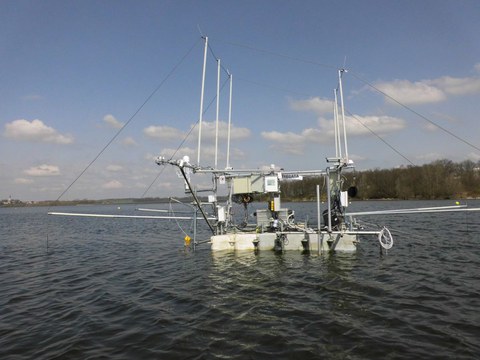MEDIWA
Meteorologische Treiber des Stoff- und Energieaustauschs zwischen Binnengewässern und der Atmosphäre
Die genaue Quantifizierung des Stoff- und Energieaustausches zwischen Binnengewässern und der bodennahen Luftschicht ist von großer wissenschaftlicher und praktischer Bedeutung. So sind zum Beispiel genaue Abschätzungen der auftretenden Verdunstungsraten essentiell für die Steuerung und Betriebsführung von Talsperren und Stauseen sowie für eine erfolgreiche Realisierung von Flutungsvorhaben in Bergbaufolgelandschaften. Die Wassertemperatur und die thermische Schichtung eines Gewässers haben großen Einfluss auf die im Wasserkörper und am Gewässergrund stattfindenden mikrobiologischen und hydrochemischen Prozesse. Entsprechend sind Kenntnisse des Wärmewärmehaushalts bzw. des Wärmeaustauschs eines Gewässers mit der Atmosphäre wichtig, um die wasserwirtschaftlichen Steuermöglichkeiten zur Verbesserung der Wassergüte in Talsperren und Stauseen effizient nutzen zu können. In gleicher Weise trägt ein exaktes Wissen über den an der Wasseroberfläche stattfindenden Gasaustauschs dazu bei, die vorhandenen Möglichkeiten zur Steuerung und Optimierung der hydrochemischen Bedingungen in einem Gewässer bestmöglich einsetzen zu können.
Exakte, direkte Messungen des an der Wasseroberfläche stattfindenden Stoff- und Energieaustauschs sind möglich, aber sehr teuer und technisch extrem aufwendig. Daher werden Stoff- und Energieflüsse (z.B. Verdunstungsraten) meist mit Hilfe von verschiedenen numerischen Modellen aus einfacher zu messenden limnologischen und meteorologischen Variablen abgeschätzt. Die Genauigkeit derartig bestimmter Austauschraten ist jedoch sehr stark abhängig von (i) der Komplexität des eingesetzten Modells, (ii) der Parametrisierung der Modellgleichungen und (iii) der Repräsentativität und Genauigkeit der zur Verfügung stehenden Eingangsdaten. In Praxis treten dadurch oftmals Konfliktsituationen auf, da die für den Einsatz genauer, komplexer Modelle notwendigen Umweltmessdaten in vielen Anwendungsfällen nicht oder nicht in ausreichender Qualität bereitstehen. Dieser Sachverhalt führt dann in Konsequenz dazu, dass der Stoff- und Energieaustausch eines Gewässers meist nur sehr überschlägig quantifiziert werden kann. Ergänzend ist festzuhalten, dass auch komplexe Modelle nach wie vor erhebliche Defizite und Schwächen in der Nachbildung der in Gewässern ablaufenden Prozesse haben. Insgesamt sind die Möglichkeiten zur Modellierung des Stoff- und Energiehaushalts von Gewässern somit stark verbesserungsbedürftig.
Mit dem Ziel Stoff- und Energieflüsse von Binnengewässern auf Grundlage allgemein verfügbarer Umweltgrößen genauer modellieren und prognostizieren zu können, sollen in dem Projekt -MEDIWA- die an der Wasseroberfläche stattfindenden Austauschprozesse intensiv untersucht werden. Auf Grundlage der gewonnenen Messdaten sollen Methoden entwickelt werden, um die Verlässlichkeit von Modellabschätzungen zu verbessern. Komplexe Zusammenhänge und Prozessketten sollen aufgelöst und durch mathematische Gleichungen beschreibbar gemacht werden. Im besonderem Fokus steht dabei die Analyse und quantitative Beschreibung, wie die zeitliche und räumliche Variabilität meteorologischer Steuergrößen den Stoff und Energiehaushalt eines Gewässers beeinflusst.
In enger Kooperation mit der Landestalsperrenverwaltung des Freistaates Sachsen führt die Technische Universität Dresden zusammen mit dem Helmholtz-Zentrum für Umweltforschung (UFZ) zwei Langzeitexperimenten auf der Talsperre Bautzen (Sachsen, Deutschland) durch. Im Rahmen dieser Messexperimente wird der Stoff- und Energieaustausch zwischen Wasseroberfläche und Atmosphäre unter unterschiedlichen meteorologischen und limnologischen Bedingungen intensiv untersucht und eine fundierte Datengrundlage zur Bearbeitung der oben genannten Aufgaben geschaffen. Ein schwimmendes Messlabor dient zur Messung der an der Wasseroberfläche auftretenden Stoff- und Energieflüsse sowie zum Monitoring der atmosphärischen und limnologischen Variablen, die von umgebenden Landflächen unbeeinflusst sind. Ein Eddykovarianz-Messsystem sowie weitere automatisch arbeitende meteorlogische, hydrochemische und hydrophysikalische Sensoren stellen kontinuierliche Messdaten in hoher (halbstündlicher) zeitlicher Auflösung bereit, wodurch die direkten Rückkopplungen und Wechselwirkungen zwischen meteorlogischen und limnologischen Variablen sichtbar werden.
Ergänzend zu diesem umfänglich ausgerüsteten Messlabor werden drei zusätzliche Beobachtungsplattformen mit einer vereinfachten Messausrüstung auf der Wasserfläche der Talsperre Bautzen verankert. Diese Plattformen dienen der messtechnischen Erfassung der räumlichen Variabilität der limnologischen und atmosphärischen Bedingungen. Entlang eines Transekts in Hauptwindrichtung werden die räumlichen Veränderungen der meteorologischen Basisparameter (Lufttemperatur, Luftfeuchte und Windgeschwindigkeit), der atmosphärischen Turbulenzsignatur und limnologischer Größen (wie Wassertemperatur, Wellenhöhe und Sauerstoffkonzentration) detektiert. Durch diese Messungen können die Effekte, die landseitig auf den Stoff- und Energieaustausch der Wasserfläche wirken, von anderen Einflussfaktoren separiert und isoliert untersucht werden. Laboruntersuchungen und ergänzende hydrochemische Feldmesskampagnen vervollständigen das Messprogramm im Hinblick auf die Effekte von Oberflächenfilmen und Mikroschichtungen an der Wasseroberfläche.
Die Kombination von experimentellen, statistischen und modellbasierten Analysen sowie die Verknüpfung von meteorologischen und limnologischen Untersuchungsverfahren bilden die methodischen Grundlagen im Projekt MEDIWA und helfen die an der Grenzfläche zwischen Wasserkörper und bodennaher Luftschicht stattfindenden Prozesse besser zu verstehen. Insbesondere können die Prozesse eruiert werden, die auf unterschiedlichen Zeit- und Raumskalen wirksam sind. Letztendlich dienen die Messungen bzw. Messdaten dazu unser Grundverständnis als auch unsere Möglichkeiten zur qualitativen und quantitativen Beschreibung des Stoff- und Energieaustauschs von Binnengewässern zu verbessern. Das Projekt MEDIWA adressiert daher sowohl die Grundlagenforschung als auch praktische Interessen der Wasserwirtschaft und des Gewässermanagements.

